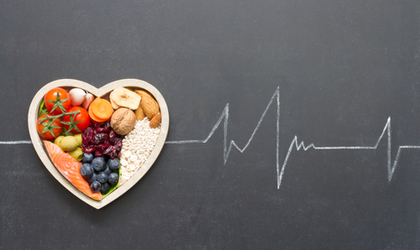
The world is currently in the tight grip of an obesity epidemic. And the outlook isn’t all too rosy for cardiovascular health. It’s now widely accepted that obesity is a risk factor in the development of heart and circulatory diseases. But it isn’t all bad news. If you’re overweight or obese, slimming down is one of the most effective ways to protect your heart health.
Did you know?
28% of adults in the UK are obesei.
A sizeable problem
The relationship between obesity and heart health is multi-layered and complex. Obesity appears to have a direct and indirect toll on cardiovascular health. Firstly, being overweight directly causes fatty material to build-up and clog your arteries, which makes a heart attack, stroke, or vascular dementia more likely. Being obese also strains the heart, leading to structural and functional changes, which amplifies the risk of heart failure.
Besides this, there’s interplay between obesity and comorbidities that may indirectly trigger heart and circulatory diseases, such as high blood pressure, high cholesterol, insulin resistance, diabetes, and sleep apnoea. The more associated medical conditions you have, the higher the risk of a cardiac event.
Did you know?
A study of 2.8 million adults revealed even slightly overweight subjects were twice as likely to get Type 2 diabetes, which can pave the way for heart diseaseii.
Visceral fat
We all need a small amount of fat to stay healthy. Too much, however – especially around your middle – may threaten to compromise your heart. Many of us are preoccupied with the fat we can feel and see, otherwise known as subcutaneous fat. But the real health menace is visceral fat – the hidden type that surrounds internal organs, like the heart and liver. This is known to increase cholesterol, blood pressure, and the risk of Type 2 diabetes, which can harm cardiovascular health.
‘Apple’ or ‘pear’?
While carrying excess weight in any degree isn’t ideal, those extra pounds around your waist are particularly problematic. Unlike ‘pears’ – who store fat below the waistline on the hips, thighs and bottom – ‘apples’ hold weight around their middle and, therefore, have more visceral fat enveloping major organs, namely the heart. Accordingly, this can heighten the risk of heart and circulatory disease.
Did you know?
Measuring your waist can determine how much visceral fat you’re storing. Preferably, waist measurements should fall below 37 inches (94cm) for men and 31.5 inches (80cm) for women.
Moving forward
-
Start performing 10-15 minutes of exercise every day, gradually working towards one full 30-minute session of moderate-intensity most days a week
-
Find a community group or ‘tribe’ to support your weight-loss goals
-
Swap unhealthy food (fast food, processed food, etc.) for high-fibre choices (fruit, vegetable, wholegrains, nuts, and seeds)
-
Add more satiating protein to your diet (beans, legumes, lean meat, and oily fish)
-
Eat plenty of fruit and vegetables every day; aim to surpass your five-a-day
-
Reduce your salt and sugar intake
-
Get a non-negotiable 7-9 hours of sleep every night
-
Prioritise self-care, relaxation and living in a stress-free way; over-eating is often emotional
Exercise can’t be left out of the conversation on heart health. Just like any other muscle in the body, physical activity helps the heart become stronger; it renders it more efficient and better prepared to pump blood throughout the body. No wonder working out has won wide acceptance as one of the best gifts you can give your heart.
An insurance policy for your heart
Regular activity trains your heart to be more robust and resilient. It lowers blood pressure, leads to healthier cholesterol levels, and promotes better blood sugar regulation – all of which keep your heart in fine fettle. Exercise also burns calories, which aids weight management and further supports overall heart health.
It doesn’t stop there, either. Exercise fosters positive physiological changes, too, such as helping the heart’s arteries to dilate more readily. It also encourages the sympathetic nervous system – responsible for controlling your blood pressure and heart rate – to be less reactive.
Heart-pumping exercise
To nourish your cardiovascular health, it’s important to strike the balance between cardio and strength training. Together, these two exercises offer the greatest benefit to the heart.
Aerobic (‘cardio’)
Improves circulation, which lowers blood pressure and heart rate, and regulates blood sugar Try for at least 30 minutes a day, at least five days a week. Example of aerobic exercise include brisk walking, cycling, swimming, tennis, skipping, or dancing
Strength-training
Helps to raise HDL (‘good’) cholesterol and lower non-HDL (‘bad’) cholesterol. Aim for at least two non-consecutive days per week. Use free weights (hand weights, dumbbells, or barbells) or body-resistance exercises, such as pull-ups, squats or push-ups.
Did you know?
Government recommendations suggest adults should perform at least 150 minutes of moderate-intensity activity or 75 minutes of intense activity every weekiii. If you can do more even better.
Move more
With the rise of office culture and sedentary jobs, many of us are sitting more and moving less. And this doesn’t bode well for our hearts. But if you examine your daily routine, you can usually find ways to squeeze more activity into it. This doesn’t have to feel like a chore. Remember, movement is a mode of transport, too. Aim for a daily goal of 30 minutes of moderate walking – that is, exercising purposefully with some effort. (If your breathing becomes more noticeable, trust you’re doing something right!)
Build exercise into your day
Are you sitting comfortably? Then it’s time to get up and move about!
-
Meet friends for a walk, not a coffee – or, just have a coffee while you walk
-
If you arrive early for an appointment, walk around the block
-
Have walk’n’talk meetings at work
-
Walk over and talk to a colleague instead of emailing
-
Try to park as far away from the supermarket entrance as possible
-
Always choose the stairs over the lift or escalators
-
Spend part of your lunch break walking
-
Cycle or walk to work instead of using the car
-
If possible, use a standing desk at work
-
Join a walking or hiking group
-
Find a walking buddy
Did you know?
Using data from more than 260,000 subjects in the UK Biobank, a five-year study conducted by the University of Glasgow found that people who cycle or walk to work have a 46% lower risk of developing heart disease compared to non-active commutersiv.
The 10,000-step myth
Born from a 1960s Japanese marketing campaign pushing pedometers, the magic daily goal of 10,000-steps offers a nugget of truth wrapped in a blanket of hype. While encouraging movement is positive, the real problem here is this number doesn’t take intensity into account. And to cultivate a healthy heart, you need to make it work hard enough to activate the pathways responsible for conditioning it.
Warning signs
We’ve all heard the expression no pain, no gain. But if your body is sending you warning signals during exercise, don’t ignore them. Notice any of the following red flags during your work out? Stop exercising immediately and consult your GP or call 999 if symptoms persist.
-
Chest pain
-
Increased shortness of breath on exertion
-
Dizziness or light-headedness
-
Heart palpitations
References:
-
Bhf.org.uk. (2019). Obesity. Available online: https://www.bhf.org.uk/informationsupport/risk-factors/your-weight-and-heart-disease
-
Kenchaiah. S, Evans. J.C., et al. (2002). Obesity and the risk of heart failure. New England Journal of Medicine. 347, 5, 305–313.
-
NHS.UK. (2019). Exercise. Available online: https://www.nhs.uk/live-well/exercise
-
Gla.ac.uk. (2019). University of Glasgow - University news - Archive of news - 2017 - May - Cycling to work may cut your risk of premature death by 40%. Available online: https://www.gla.ac.uk/news/archiveofnews/2017/may/headline_522765_en.html
You Might Also Like

Olivia
Olivia Salter has always been an avid health nut. After graduating from the University of Bristol, she began working for a nutritional consultancy where she discovered her passion for all things wellness-related. There, she executed much of the company’s content marketing strategy and found her niche in health writing, publishing articles in Women’s Health, Mind Body Green, Thrive and Psychologies.
View More



